How to connect a chandelier with a remote control
Remote control of household appliances long ago and firmly embedded in modern life. You can control televisions, sound systems, etc. without moving from your seat. Smart Home systems have expanded the control limits of appliances to the maximum possible. Ceiling chandeliers are now also controlled from the spot.
Mounting and fixing the LED chandelier
LED chandeliers with remote control, like other types of fixtures, are attached to the ceiling using the standard installation devices provided. In most cases, this is the bar, which must be attached to the ceiling with dowels. They often also come with the kit. If they are not there, which is typical for the cheapest Chinese chandeliers, then you must buy the fasteners separately.

Holes to install any LED chandelier is drilled in the ceiling with a drill, equipped with drill bits on concrete. First, the bar is fixed on the dowels, then the chandelier is attached to it. The order of the work depends on the design of the chandelier and is almost always described in the instructions.

If the chandelier is large and heavy, it is better to hang it on a hook. In older houses, such hooks are already provided.
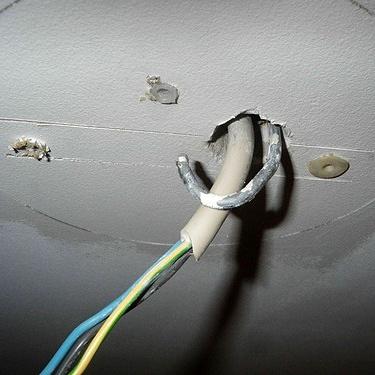
To hang serious chandeliers in more modern homes, you can buy an anchor with a hook. It expands in the drilled hole and can withstand heavy loads.

Read more about installation methods: Mounting and installation of the chandelier
Wiring diagram
To connect any chandelier you do not need to know its internal structure. A chandelier with a remote control is connected to the mains like an ordinary lamp:
- phase wire to terminal L;
- neutral wire to terminal N;
- If there is a protective conductor, it is connected to the terminal marked PE or the grounding symbol.
The wiring diagram of the luminaire as a "black box" using a distribution box is shown in the figure. The wall switch is the main light. If it is turned off, the remote control will not affect the operation of lighting.
Important! If you use a luminaire of protection class 1, protective earthing is the only (in addition to basic insulation) measure of protection against electric shock in case of breakdown of insulation layer. You can not use it in TN-C networks - it will work, but will not provide safety.
But knowledge of the internal structure will not be superfluous to understand the operation of the device as a whole, as well as to perform, if necessary, repair work.
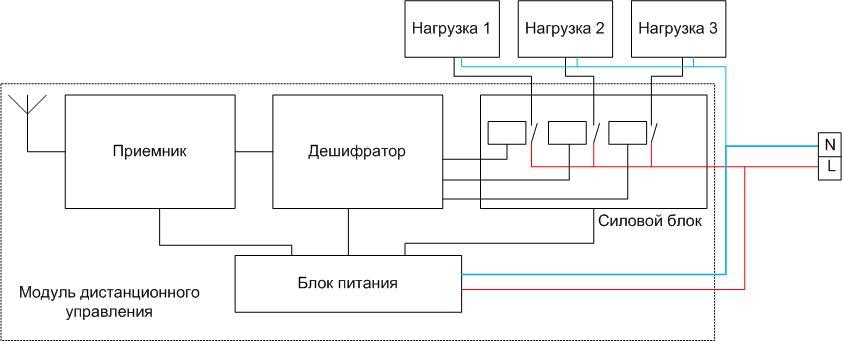
Most remote-controlled chandeliers contain a remote control module that switches loads, such as lighting fixtures. Usually there are 1...3 of them, the usual incandescent bulbs (or groups of them), LED or halogen bulbs.
The remote control modules can be assembled on different components and according to different schemes, but the block diagram of most of them is the same:
- The receiver serves to receive, amplify and filter the signal transmitted by the remote control. Infrared communication channels between the transmitter and receiver, common in household equipment, are rarely used in chandeliers because of the high level of thermal noise emitted by the lamp. Simple chandeliers are controlled via radio, advanced chandeliers are controlled via Bluetooth or WI-Fi. The latter two options are often used in complex devices with dimming or with light effects that are controlled via mobile gadget app.
- The decoder receives the generated pulse sequence from the receiver and "decodes" the command. Depending on the task, it forms a signal to turn on or turn off one of the loads, and in complex models to change the brightness level of the glow.
- The generated command is amplified in the power unit. If dimming is not required, the load is switched by electromagnetic relay. If you need to change the brightness or chromaticity, the power unit is a PWM regulator with electronic keys.
- The power supply forms a constant voltage to supply all elements of the circuit.
If the load is halogen or LED lamps, the chandelier will have additional control devices.
Unit for halogen lamps
Halogen lamps are not connected to a 220 volt mains supply not directly but with a step-down transformer. Nowadays, most of them do not use conventional transformers with a magnetic core and two windings, but electronic transformers. They work according to different principles, so their dimensions and weight are lower. In this case also lower reliability, but higher level of interference generated in the supply network. Such a transformer is switched on the 220 volt side - there are lower currents for equal power, and higher longevity of relay contacts.
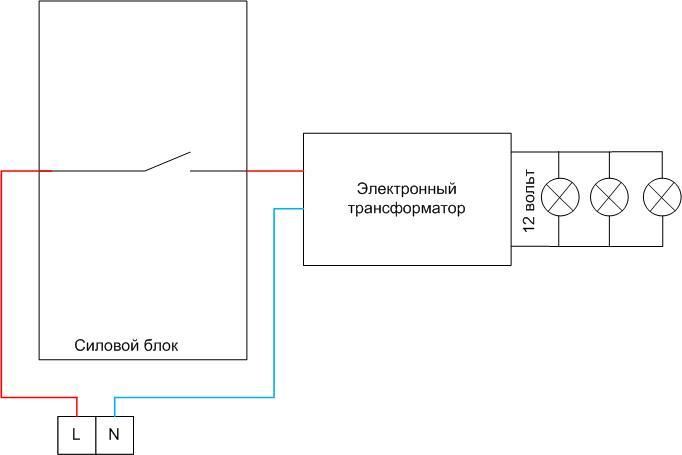
At chandelier connection to the 220 volt network, the presence of halogen lamps and any type of transformer has no effect. It should be borne in mind that when replacing the lamps, their total power should not exceed the load capacity of the transformer.
| Lamp type | Voltage, V | Power Consumption, W |
|---|---|---|
| Visico ML-075 | 12 | 75 |
| NH-JC-20-12-G4-CL | 20 | |
| Navigator 94 203 MR16 | 20 | |
| G4 JC-220/35/G4 CL 02585 Uniel | 35 | |
| Elektrostandard G4 | 20 |
When installing, sum the total power of the lamps and compare it to the maximum allowable (indicated on the transformer housing).
LED unit
LEDs are turned on through a current regulator driver. It reduces the voltage on the serial and parallel The LED circuit is used to control the LEDs and stabilize the current through the LEDs.
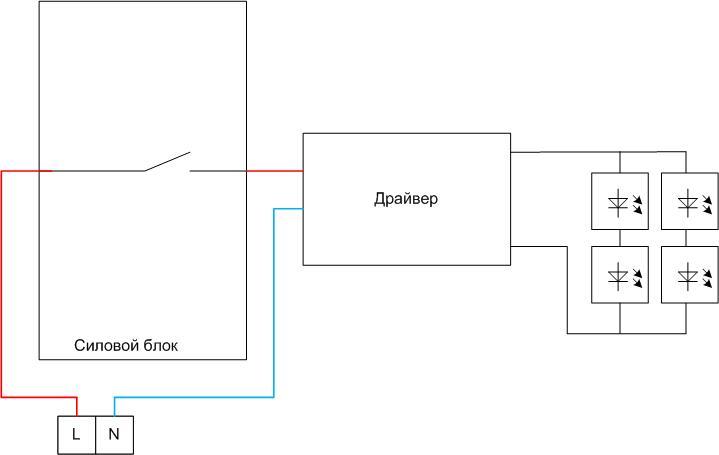
In advanced models, allowing you to control not only the switching on and off LEDs, but also regulating their brightness and changing color, the driver is combined with a power unit. PWM regulator output transistors serve as keys.
How to tie the remote to the chandelier
In some remote control systems you need to bind the remote control to the chandelier (synchronize). This procedure can be done with one remote and several chandeliers in different rooms and control them with one device (though you will have to carry the remote with you all the time). You can try to bind your remote to each fixture in the room and control them independently. The procedure varies from manufacturer to manufacturer, but in general it is about the same:
- apply voltage to the chandelier from the wall switch;
- wait a few seconds and then point the remote control at the chandelier;
- Press the dedicated button for synchronization;
- In a few seconds the lamp will respond in the form of one or more flashes and will go into the light mode.
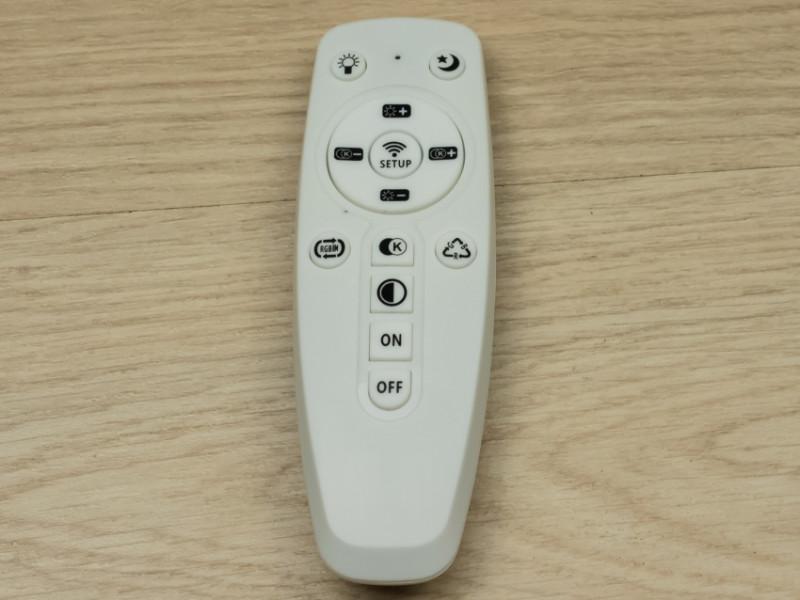
Button for primary synchronization is most often marked in the form of a radio signal symbol, but not necessarily. It can be a button of one of the channels or just a light button. Usually the whole setup procedure with the buttons is described in the manual.
Checking and possible malfunctions
If everything is connected correctly, and the chandelier does not respond to pressing the buttons, first of all you should check the presence and condition of the batteries in the remote control. If necessary, they must be installed or replaced with fresh ones. Unlike infrared remotes, it is not possible to check the functionality of the radio frequency device with a smartphone. You can try to catch the signal on the radio, but household devices do not have the 433 MHz band, let alone 2.4 or 5 GHz (for Bluetooth or Wi-Fi).
If there is no response to the remote after replacing the batteries, you can check for line voltage on the input terminals of the chandelier. If there is power, you can assume a malfunction of the remote control or the receiving module.
In a situation when when when you press the remote control buttons you hear the clicks of electromagnetic relays, but one or more lights (groups of lights) do not light up, first of all you should check the voltage at the corresponding output of the control module. If it is very different from 220 volts, then the contact group of electromagnetic relay is faulty. If everything is OK, it is assumed that the light-emitting element or the driver (if any) is faulty. If the bulb is easily removable, its functionality can be checked by replacing it with a known faulty one. If the mounting is hard (soldering, etc.), you can try to check the element with a multimeter (the LED is tested like a normal diode in both directions). If everything is OK here, you should check the voltage at the output of the driver or the step-down transformer - it should not differ too much from the one indicated on the chassis. In case of failure the module should be replaced.
To reinforce the information, there is a video.
In general, the connection to the network of the chandelier with a remote control does not have fundamental differences from the same procedure for conventional lamps. With careful and error-free installation, the lighting fixture begins to work immediately, although some models will need to bind the remote.
